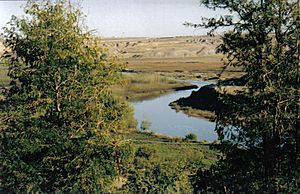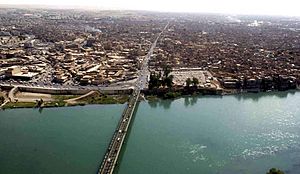Tigris facts for kids
The Tigris is a very important river in the Middle East. It is one of two big rivers that helped create ancient civilizations in a region called Mesopotamia. Mesopotamia means "the land between the rivers." The other river is the Euphrates.
The Tigris River starts high up in the Taurus Mountains in Turkey. From there, it flows through parts of Turkey and forms a small part of the border between Turkey and Syria. Most of the river then flows through Iraq.
The river is about 1,900 kilometres (1,181 miles) long. Near its end, it joins with the Euphrates River. Together, they form a waterway called the Shatt-al-Arab, which then flows into the Persian Gulf.
A River of History
The Tigris River played a huge role in the development of early human civilization. Thousands of years ago, the land around the Tigris was very fertile. This meant it was great for farming.
Farming and Early Cities
Ancient farmers learned to use the river's water to irrigate their crops. This helped them grow much more food than before. With more food, more people could live together in one place. This led to the creation of the very first cities and large communities.
Many famous ancient cities, like Nineveh and Ctesiphon, were built along the banks of the Tigris. These cities became centers for trade, learning, and culture. The river was like a highway, allowing people to travel and move goods. It also provided water for drinking and daily life.
Why Water Was Key
Having a reliable source of water from the Tigris allowed these early societies to grow and become powerful. They developed new ways of living, including writing, laws, and complex governments. The Tigris, along with the Euphrates, truly helped shape the world we live in today.
Images for kids
See also
 In Spanish: Tigris para niños
In Spanish: Tigris para niños







